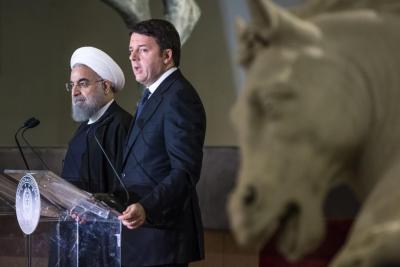Iranian president's controversial Italian visit

ROME -- Iranian president Hassan Rouhani's visit to Italy has led to both developments and controversies, with historic economic and political agreements being signed whilst protests against Iran's brutal human rights record took place outside.
Speaking about Iran's recent return to the international playing field after years of isolation and heavy sanctions, lifted after the signing of the Vienna agreement last July, Italian Prime Minister Matteo Renzi emphasised that "Rouhani's role is fundamental to regional stability. We will work together for peace." "The historical friendship is founded on the cultural relations between Rome and Tehran, a symbol of our past but also, I would like to think, of our future."
After meeting with Rouhani on Monday, Renzi expressed hopes that the two countries could work together towards peace in the Middle East, and particularly on finding a diplomatic solution to the Syrian conflict, which he emphasised would have to include all regional players including Israel and Saudi Arabia. "Undoubtedly the efforts which led to the Vienna agreement will be the first step towards a new stage of peace and prosperity, not only for Iran but for the whole region."
Rouhani himself spoke not just of political cooperation but also economic, saying that, "if we want to combat extremism and violence in the world, if we want to fight against terrorism, one of the paths we have is that of economic development, and the creation of jobs." "The lack of development creates opportunities for terrorism, and unemployment creates recruits for terrorists."
The fruits of the visit have included the signing of business contracts worth 17 billion euros, as well as the signing of a declaration for bilateral cooperation.
However, concerns have been raised regarding the overlooking of the question of human rights, for which Iran has attracted international criticism. Protests took place on Tuesday in Piazza del Pantheon, which condemned the enforcement of Islamic fundamentalism and the Iranian regime's support of Syrian dictator Bashar al-Assad. Placards drew attention to Iran's continued use of the death penalty, under which 1000 people have been executed in 2015 alone and 2277 hanged under Rouhani's presidency so far. There were also references to Camp Liberty, a base for members of Iran's Mujahedin opposition movement which was attacked with a collection of 80 missiles in October 2015, killing 24 residents.
In an interview in La Repubblica, Emma Bonino, former Italian minister of foreign affairs, expressed concern that certain discussions, for example "the issues of the death penalty, of human rights" should not be forgotten "in the development of our political relations."
On Tuesday Rouhani's visit continued on to the Vatican to meet Pope Francis, whilst his minister for foreign affairs met Italian foreign affairs minister Paolo Gentiloni. Pope Francis emphasised the importance of Iran's role in fighting terrorism and Rouhani, speaking at the Italy-Iran Business Forum, outlined the similarities between the two religions. He said that the Koran teaches that "the church, the synagogue, and the mosque all stand beside each other," and that as such they should all be respected and preserved. "This is the culture of tolerance that the Koran teaches us." He asked the Pope to pray for him.


